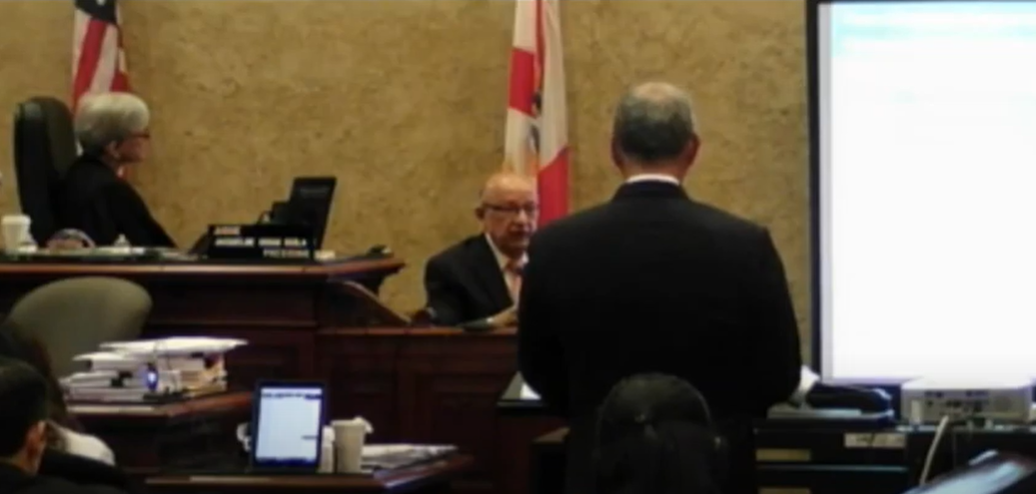

The Expert: Dr. Suresh Moolgavkar, an epidemiologist based in Washington, testifies for the defense and discusses his conclusions on mesothelioma.

Offering testimony in Gonzalez v. Caterpillar, a 2015 Florida state trial in which the family of a deceased mechanic pursued claims against heavy equipment giant Caterpillar and auto parts manufacturer Dana Co. LLC, Dr. Suresh Moolgavkar, a medical doctor, epidemiologist, and mathematician, sits for the defense. The claims were in the categories of asbestos, negligence and product liability. The plaintiff alleged that Mr. Pablo Gonzalez had died from cancer after decades of exposure to asbestos within the products these companies manufactured, and that the companies were aware of this yet failed to provide adequate warnings.
In this clip, the expert establishes doubt that mesothelioma is always related to asbestos exposure. He begins by explaining what the term “signal tumor” means. Signal tumor implies that if a particular type of tumor is found within a patient, that a certain type of exposure should be suspected and inquired about. For instance, lung cancer is a signal tumor for tobacco smoking. If lung cancer is detected, the doctor is obligated to ask about a history of cigarette smoking since most lung cancer is associated with this. Similarly, a male found to have a pleural mesothelioma, should be asked about exposure to asbestos, particularly amphibole asbestos or high levels of chrysotile asbestos, because historically these pleural mesotheliomas are so frequently, though not always, caused by such exposure. In contrast, chicken pox is by definition caused by the chicken pox virus. It cannot be caused by anything else. Mesothelioma on the other hand, can occur spontaneously, it can occur from exposure to amphibole asbestos or high dose chrysotile asbestos, it can be caused by exposure to erionite [found in volcanic ash particularly in western states], and it can be caused by exposure to ionic radiation.
Dr. Moolgavkar next addresses the supposition that there is no safe level to the exposure of asbestos. There have been numerous epidemiologic studies that show that low levels of chrysotile asbestos, even when contaminated with amphibole asbestos, do not increase the risk of mesothelioma. The doctor says that some doctors will not accept that there is a level of asbestos exposure below which there is no longer any risk of mesothelioma, because they simply argue that despite so many studies demonstrating epidemiologically that this is the case, they feel the sample size is too small to draw a conclusion. This expert states plainly that he believes that the sample size is adequate to make the assumption that low levels of exposure will not lead to the disease.
Regarding spontaneous generation of mesothelioma, the expert offers that all carcinomas have a percentage of cases that generate spontaneously. This is supported in mesothelioma by cases within studies that report no exposure to chrysotile or amphibole asbestos, radiation, or erionite. Studies of the number of cases in registries of pleural mesothelioma attributable to asbestos exposure are always less than 100%. In fact, the fraction of cases of pleural mesothelioma among men in this country which are not attributable to asbestos exposure is 15-20%. Cases of mesothelioma have even rarely been discovered in newborn children.
The SEER program, or Surveillance Epidemiology End Results program of the National Cancer Institute, consists of the accumulated cancer registries around the United States since 1973. The program serves as a main source of statistical information for those studying cancer trends in this country. SEER 9 was the original containing nine registries, then in 1992, SEER 12 expanded upon the original 9 with three more, then SEER 18 had eighteen registries and so on. This expert published a study in 2009 based on SEER 9 which covered pleural and peritoneal mesothelioma from 1973 to 2005. This study examined the rate of spontaneous mesotheliomas in the population. He concluded that there were 2-3 cases of spontaneous pleural mesothelioma per 1 million people per year. The lifetime risk for spontaneous pleural mesothelioma is about 3 per ten thousand. By comparison, the lifetime risk for never smokers developing lung cancer is about 8 per ten thousand. So despite the relative rarity of spontaneous mesothelioma, it does exist.
After a 14 day trial, the jury unanimously ruled in favor of the defense while deliberating for only a few hours.
Gary Gansar, MD, is residency-trained in general surgery. He served as Chief of Surgery and Staff at Elmwood Medical Center and on the Medical Executive Committee at Touro Infirmary and Mercy Hospital in New Orleans, LA. Dr. Gansar was Board Certified in general surgery while in active practice. He joined AMFS in 2015 as a Physician Medical Director.
The medical expert witness partner for attorneys serious about building a winning case
AMFS is your trusted source for highly-qualified medical expert witnesses. After pioneering the field nearly three decades ago, we’re continuing to redefine medical expert witness services by providing value far beyond a referral alone.
Our Physician Medical Directors know what it takes to build a strong case. Our medical expert witnesses leave no doubt. And our case managers streamline billing and logistics every step of the way, letting you focus on what you do best: constructing your winning case. Explore why AMFS clients expect more from their medical expert witnesses—and get it.
